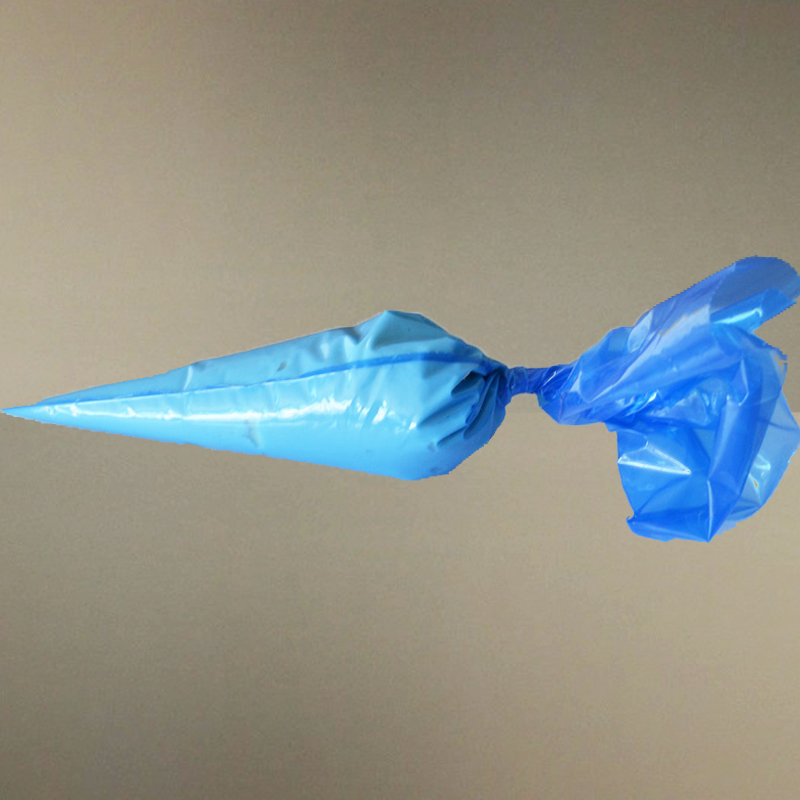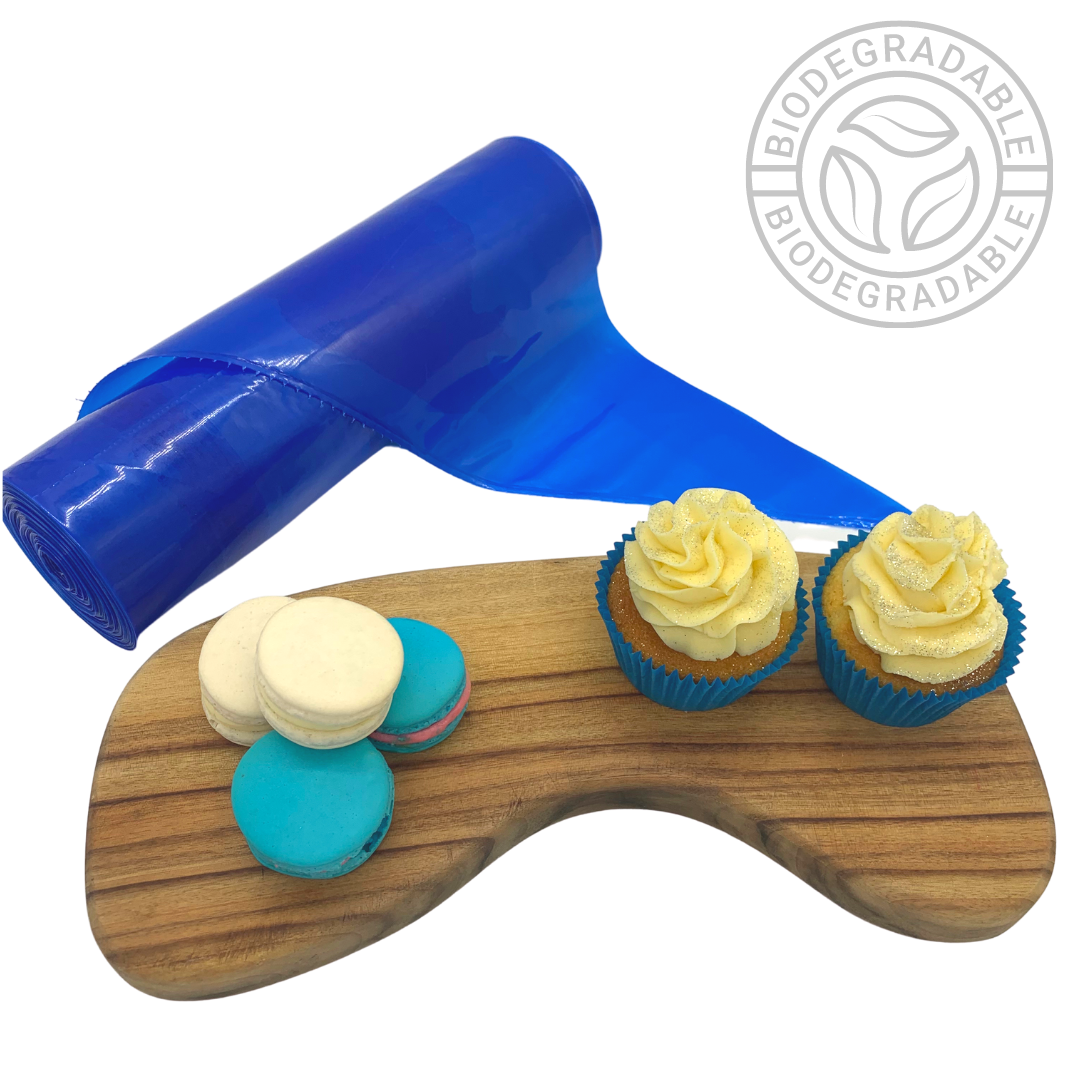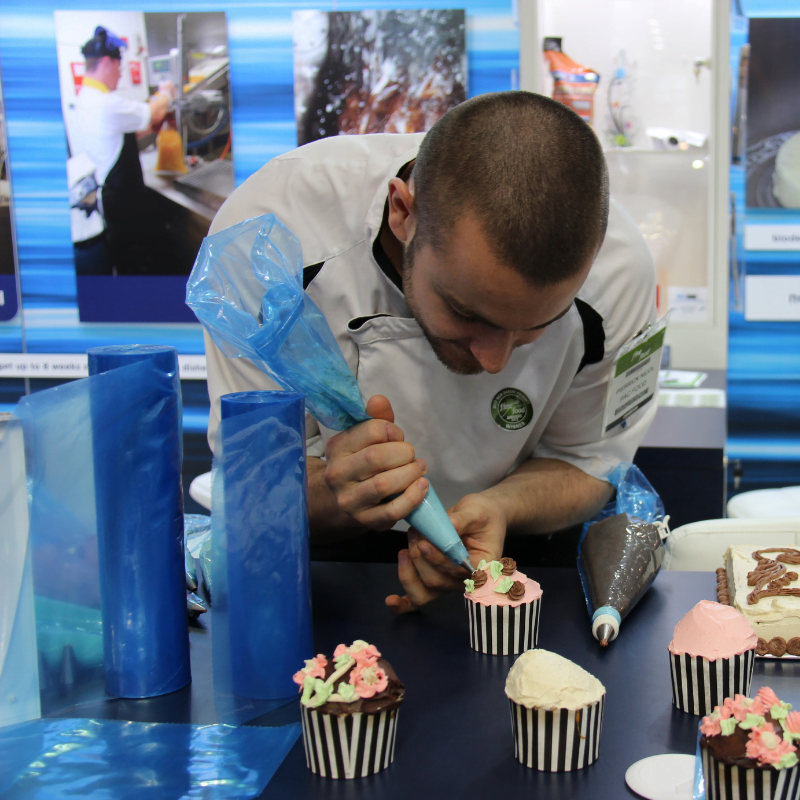A great piping bag can make all the difference between stunning, effortless decoration and a frustrating, messy experience. For professional pastry chefs and home bakers alike, choosing the right piping bag is crucial for achieving the perfect design.
With so many materials, designs and features on the market, how do you decide which is best for your next patisserie project? Let’s get into it.
What are Piping Bags?
Piping bags are used to pipe cream, frosting or other mixtures onto or inside cupcakes, cakes and pastries.
Sometimes referred to as pastry bags, they’re a crucial part of any kitchen, most commonly used for frosting intricate designs when cake decorating, filling eclairs and squeezing dough or batter onto baking trays.
Available in a range of sizes and materials, there’s a piping bag variation for every baking need. The type of tip you choose is also important. This will influence the outcome of your piping design. A star or rounded tip can help create a smooth, even finish usually achieved only by the very best bakers.
Creaming bags, on the other hand, are designed for use with softer substances and aren’t as heavy-duty as piping bags.

Types of Piping Bags
Recyclable Piping Bags
Recyclable piping bags are a favourable option for high-volume kitchens where convenience is key and large quantities of icing are used. Environmentally friendly and disposable yet still heavy-duty, these piping bags are a great choice for businesses that want to avoid additional cleaning.
Reusable Piping Bags
Reusable piping bags need to be cleaned after every use which can be time consuming, particularly in large, high-output kitchens. They’re very durable, however, so can withstand many activities over a long period.
Silicone vs. Plastic vs. Cloth Bags
The most common piping bag materials are silicone, cloth and plastic bags, each offering advantages.
Silicone bags are flexible and easy to clean, making them a top choice for many bakers, though be aware they could be too soft for some thicker fillings.
Plastic bags tend to be disposable after one use although they are sometimes thick enough to be cleaned and used again.
Cloth variations are a more traditional option. They’re very sturdy but some bakers struggle with cleaning them and maintaining optimal hygiene over time.
What to Look for in a High-Quality Piping Bag
When choosing a piping bag, quality matters. Always opt for durable bags made from high-quality material that won’t tear or stain. A well-designed piping bag should be easy to use, fill, handle and in the case of reusable models, clean.
Material & Strength
Strong, tear-resistant bags are essential for handling mixtures such as ganache or buttercream frosting. Available in various materials including silicone, plastic or cloth, the most suitable option will depend on the nature of your baking project.
At Pac Food, our piping bags offer superior durability thanks to high-quality materials that resist tearing under pressure.
Grip & Texture
The best piping bags have textured or non-slip surfaces that offer an extra level of control for your intricate designs. A slippery piping bag spells disaster for a beautifully decorated cake.
At Pac Food, all of our piping bags are anti-slip, offering a secure grip to make frosting cakes with precision easier than ever.
Size Matters
Piping bags come in different sizes and choosing the correct one will result in the best outcome for your project. Smaller 12-inch bags are best for small details and intricate designs. 16-inch bags are a versatile option suitable for most decorating needs while larger piping bags are ideal for kitchens undertaking a high volume of piping.
Tip Compatibility
From a small piping tip to larger piping tips, your bag needs to be compatible with the size you choose. Some may require cutting of the tip (simply snip a little off the end) to fit a specific attachment while others offer the convenience of pre-fitting.
Using Piping Bags Effectively
Filling and Handling Piping Bags
Before you start piping you need to properly set up the bag for use. Start by placing the tip into the bag and use a spoon or spatula to fill it with your mixture of choice. Be careful never to overfill your bag.
When you’re ready to pipe, we recommend holding the bag at a 90-degree angle before carefully squeezing the mixture onto your bake of choice.

Preventing Leaks, Bursts, and Clogs
Leaks or bursts can occur when a piping bag is overfilled, or too much pressure is applied. To avoid this, never overload the bag. It’s easier to add more as you go than fix a ripped bag.
Clogs often indicate that the wrong size or shape tip is being used. To overcome this, try swapping to a different piping tip and ease the pressure on the bag.
Using a piping tip coupler can help keep the tip securely in place and prevent it from coming loose. For the best results, apply consistent, even pressure throughout the process to ensure smooth piping without interruptions.
Piping Bag Performance for Different Demands
Piping bags, as opposed to cream bags, are durable and designed to handle thicker substances, making them a suitable option for most piping work. Let’s explore some of the most common demands our piping bags face in the kitchen.
Buttercream
Buttercream is used for various cake decorating techniques, including in the middle of a layer cake or piping rosettes. Squeezing a thick mixture onto cakes means strong bags are required to ensure they don’t burst under pressure.
Royal Icing
When using royal icing to decorate cupcakes or biscuits, for example, precise, small piping bags are the optimal choice. As a thinner mixture, choosing a smaller bag allows bakers to show off their piping skills, create finer details and achieve maximum intricacy.
Whipped Cream
Whipped cream requires a piping bag that is both flexible and firm to allow for smooth, effortless piping without the risk of the bag collapsing under pressure. Whipped cream is a great opportunity to try different-shaped nozzles to achieve varied results.
Ganache & Chocolate
As ganache is often piped when still hot, choosing a heat-resistant bag is essential. Pac Food’s bags are heavy-duty and able to handle very thick ganache. Our piping bags have even been used to pipe mortar in the building industry to prove just how durable they are.
Choux Pastry & Macarons
The filling of these types of bakes requires high-pressure piping so reinforced bags are very important.
Common Mistakes to Avoid When Choosing a Piping Bag
Some common mistakes keen bakers make when piping include:
- Choosing a thin bag for thick mixture
- Using the incorrect-sized bag
- Buying a piping bag with a limited grip
- Using a cream bag instead of a piping bag

Why Pac Food’s Piping Bags Stand Out
Pac Food’s piping bags literally stand out from the crowd thanks to their blue colour—perfect for the kitchen.
They stand out for plenty of other reasons too like their durability, strength, high-quality material and eco-friendly and food-safe properties.
Whether you’re decorating cupcakes for a friend’s birthday or working in the kitchen of a five-star restaurant, you can count on Pac Food to ensure you never have a cake decorating fail due to a burst bag again – happy baking!
Frequently Asked Questions
What size piping bag should I get?
The most appropriate sized piping bag depends on your project. Smaller bags are better for fine details, while larger ones are ideal for bulk piping.
How do I know which piping tip to use?
The best piping tips for your project should be chosen for the desired effect. Star tips create ridges, small tips help with intricacy and round nozzles are the best choice for smoother designs.
Is it better to use reusable or disposable piping bags?
Reusable bags are very durable, but disposable piping bags offer similar strength with the added convenience of no need for cleaning. Pac Food is proud to have introduced the first non-reusable, yet recyclable piping bags on the market, offering a more sustainable choice without compromising on convenience.
Does the piping tip go inside or outside?
Typically, the tip goes inside before you fill the bag with the mixture.

